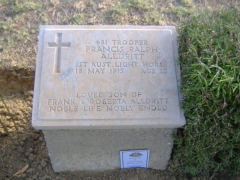Enlistment Address
Curban, NSW
Service Number
481
Unit
1st Light Horse
Comment
Gilgandra War Memorial
Fate
KIA 18.5.1915,
Information
Private Alldritt was a farmer in the Gilgandra district, working with his uncle and a younger brother, Gregory, at ‘Ulomogo’ Curban, when he enlisted on August 28, 1914 at Roseberry, Sydney with the 1st Light Horse. Many of the local Gilgandra & district young men enlisted with the Light Horse, as their riding and shooting skills were highly valued. He embarked for Egypt on the ‘Star of Victoria’ on October 20, 1914 and disembarked on Secember 8, 1914.
The light horse were initially considered unsuitable for the Gallipoli operation, but were soon deployed without their horses to reinforce the infantry after the disastrous start to the Dardenelles Campaign. The 1st Light Horse Regiment landed on May 12, 1915 and Francis was killed 6 days later on May 18, 1915.
He was killed at ‘Monash Valley’ on May 18,1915 and buried by Chaplain E Merrington on May 20, 1915. There are several reports in his service record of where he was buried. One says the Military Burial Ground, Popes Hill and another says Shrapnel Gully in CVll; Grave lll. A photo of the grave at Popes Hill Row B Grave 5 was sent to his father. He is now in the Quinns Post Commonwealth War Grave Row B Grave 5. Quinn’s Post was established on the afternoon of the 25 April by a New Zealand machine-gun crew. In the coming months, the post was held by a number of different Australian and New Zealand units and was the subject of incessant attacks and continual hand-to-hand fighting with the Turkish post opposite, who knew it as ‘Bomba Sirt’ (Bomb Ridge). The post was named from Major Hugh Quinn of the 15th Battalion, Australian Infantry, who was killed there during a fierce attack on 29 May. Major Quinn is buried in Shrapnel Valley Cemetery. The original cemetery was made after the Armistice by the concentration of 225 isolated graves, all unidentified, into Rows E to I. Rows A to D were added later. The graves from Pope’s Hill Cemetery, and six other graves found later, were brought into a plot, at the north-east end. Pope’s Hill Cemetery was at the foot of Pope’s Hill, where the track turned up to Quinn’s Post. The hill was named from Lt. Col. H. Pope, then commanding the 16th Australian Battalion, which reached it on 25 April. There are now 473 Commonwealth servicemen of the First World War buried or commemorated in this cemetery. 294 of the burials are unidentified. Special memorials record the names of 64 soldiers, most of them Australian, who were known or believed to have been buried in Quinn’s Post Cemetery or Pope’s Hill Cemetery
Francis was born in Sydney, attended Fort St High School and was 5’5” tall and weighed 9 stone. He had a florid complexion, blue eyes and yellow hair.
He was the eldest child of Francis and Roberta Alldritt and two of his brothers also served in WW1. Brier Northey Alldritt was in the 3rd Battalion and Robert Gregory in the 18th Battalion; both survived the war.
A report in the Gilgandra Weekly on June 8, 1917, says Francis’ brother Gregory Allsdritt visited Mr and Mrs Priddle of ‘Ulomogo’ Curban,. Gregory was with the 18th Batt in Gallipoli when he was wounded and sent to Alexandria Hospital where there were 6000 wounded soldiers. Their brother, Northey was in the fighting at Lone Pine and subsequently spent 12 months in France, being ‘in the thick of it’ at Pozieres. The article goes on to say ‘ the Alldritt family have done their share in the great struggle- and done it well’.
Margo Piggott and Rees Howard commemorated Ralph Alldritt at Quinns Post cemetery in 2010. Ralphs’ name is on the Gilgandra War Memorial, the St Stephens Uniting Church, Sydney War Memorial, the Mosman War Memorial and of course the Australian War Memorial on Panel 2.
